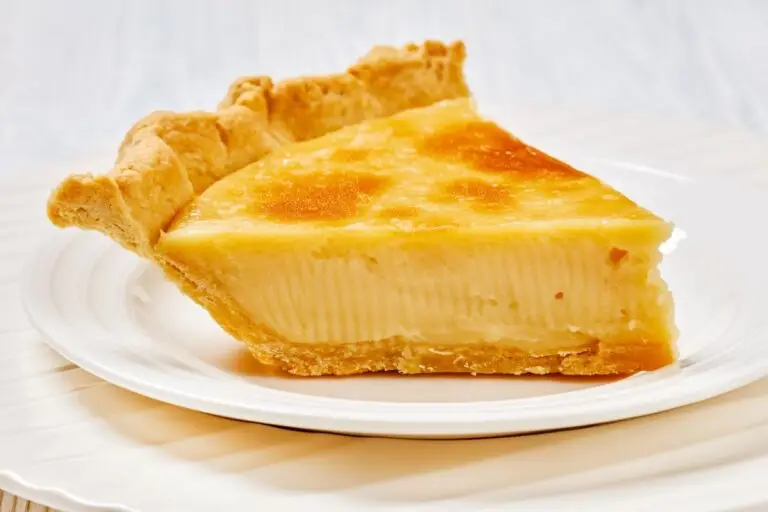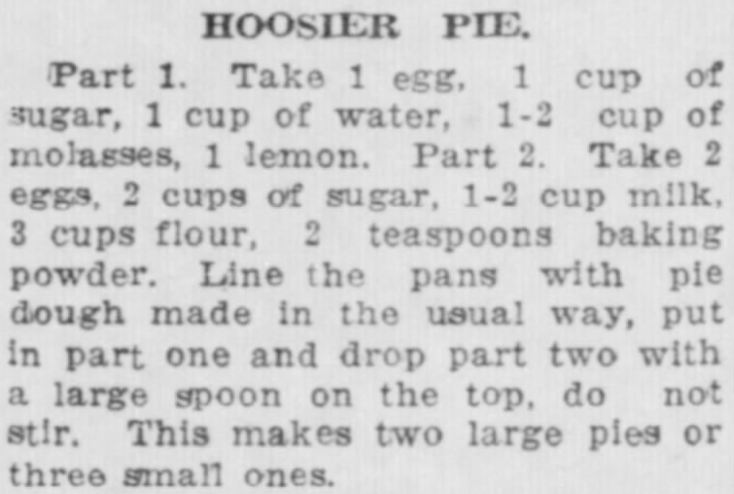In the world of beloved family recipes, some versions get lost to time, just waiting for a new generation to rediscover them. That's the story of this incredible 1921 original Hoosier pie recipe. This isn't your typical Indiana sugar cream pie; it's something far more intriguing, with molasses and lemon creating flavors that'll surprise your sweet tooth.
The State Pie of Indiana
Every delicious pie has a story, and this one is rooted deep in Hoosier history. Back in the 1800s, when pantries ran bare and fresh fruit was scarce, resourceful home cooks in Shaker communities across the Hoosier state created what they lovingly called a "desperation pie." But don't let the name fool you - this dessert is a testament to their incredible creativity and ability to make something truly special from the simplest of ingredients.
When apple harvests dwindled and winter stretched long, our ancestors turned to common ingredients they always had on hand: milk, sugar, flour, and eggs. This simple pie has become such a beloved classic American dessert that Indiana designated it as its state pie in 2009.
1921 Hoosier Pie Recipe
What makes this version so special? This recipe features a two-layer approach. The bottom layer combines eggs, molasses, and bright lemon juice, while the top transforms into a cake-like topping that's pure magic.
This isn't a standard custard pie; it's something entirely unique that bridges the gap between easy pies and more complex creamy desserts. Think of it as a cousin to chess pie or buttermilk pie, but with its own distinct personality.
Hoosier Pie Deserves a Comeback
In our world of instant everything, there's something really satisfying about recreating a recipe that delighted families over a century ago. This pie offers a velvety texture that's both familiar and surprising, with the molasses adding depth and the lemon providing just enough brightness to balance the sweetness.
This 1921 gem deserves a spot in your regular rotation. It's the kind of pie that tells a story with every bite, connecting you to generations of resourceful home cooks who knew that the simplest ingredients, when treated with care, create the most memorable desserts.

Hoosier Sugar Cream Pie
Bake a piece of history with this 1921 Hoosier Sugar Cream Pie recipe. Unlike the modern sugar cream pie, this treasured recipe features a delightful and surprising combination of rich molasses and bright lemon in its custard base. The real magic happens in the oven, where a simple batter dropped on top bakes into a distinct, cake-like layer, creating a one-of-a-kind dessert that’s both comforting and unique. Enjoy a sweet slice of the past.
- Total Time: 55-70 minutes
- Yield: 6-8 slices 1x
Ingredients
Ingredients for the Filling:
- 1 egg (room temperature works best)
- 1 cup sugar
- 1 cup water
- 1/2 cup molasses
- Juice of 1 little bit of lemon (about 2-3 tablespoons)
Ingredients for the Topping:
- 2 eggs
- 2 cups sugar
- 1/2 cup milk
- 3 cups all-purpose flour
- 2 teaspoons baking powder
Instructions
- Press a pie crust into a 9-inch pie pan and crimp the edges.
- In a mixing bowl, whisk together the single egg, sugar, water, molasses, and fresh lemon juice until the mixture is smooth.
- In a separate bowl, whisk the remaining eggs, sugar, milk, flour, and baking powder to create a thick batter.
- Pour the molasses mixture into the unbaked pie shell.
- Gently drop spoonfuls of the thick batter over the molasses mixture. Do not stir them together.
- Preheat your oven to 375°F. Bake for 35-45 minutes, or until the top is golden brown and the filling is set but still jiggles slightly. If the crust edges brown too quickly, cover them with foil.
- Let the pie cool completely at room temperature.
- Chill for several hours or overnight before slicing and serving.
- Store, covered, in the refrigerator for up to one week.
- Prep Time: 20-25 minutes
- Cook Time: 35-45 minutes
- Category: Dessert
- Method: Baked
- Cuisine: American
Tips
- Temperature matters for your ingredients. Room temperature eggs blend more smoothly into both the molasses filling and cake-like topping, preventing lumps and creating that silky texture this pie is famous for. Take your eggs out about 30 minutes before baking.
- Create the perfect topping layer. When dropping spoonfuls of the thick batter over the molasses mixture, aim for even coverage but don't worry about perfection. The batter will spread and create that signature marbled effect as it bakes. Resist the urge to stir - the magic happens when these layers stay separate.
- Patience pays off with cooling. This pie absolutely needs to cool completely at room temperature before refrigerating. Rushing this process can cause the layers to become watery or separate. Plan for at least 2-3 hours of cooling time.




0 comments